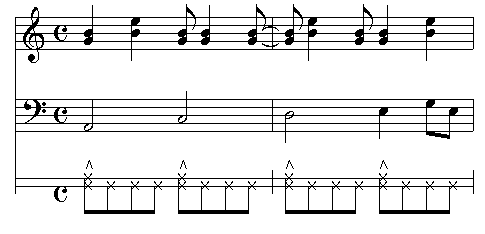a.k.a. When Good Charts Go Bad!
There are a lot of bad charts out there. When I was a teenager, the “urban semi-myth” that circulated among the local garage bands was that all the wrong chords in the charts that we bought were put there deliberately, to avoid violating some obscure principal of copyright law (the “if you change a note, it’s not copyright violation” theory. Hey, we were teenagers!) Anyway, we didn’t seem to grasp the fact that the authorized publishers of a song can hardly be guilty of copyright violation.
But I digress. Charts that are close but have some questionable spots are not only found in legitimate published sheet music, but also (no surprise) in unauthorized collections of songs and also in the charts that musicians make for each other.
So how do you correct a problematic chart? You get one or more great recordings of the song in question and listen to what they did there. Then you decide whether or not you want to do the same thing.
It’s pretty easy to work out chords if you have any tool that facilitates repeating a section of music over and over again. This might be an A-B repeat switch on a CD player, an looping tool in an audio editing or playback program, or a tool designed expressly for this type of purpose. I am the author of such a tool, SlowGold, and I will use that to illustrate the technique, but the general principles apply regardless of what tool you use.
Working out harmonies from recordings usually consists of several steps:
- Figure out what the bass is doing
- Transcribe the melody notes
- Use logic to narrow the possible chords and trial-and-error to discover the correct ones
Case Study
I will give a jazz example, but the technique applies equally well to many other forms of music.
Felicidade is a great samba by the late Antonio Carlos Jobim, Brazil’s most popular musical export. It was featured in the classic film, Black Orpheus, and has become a standard played frequently by jazz artists the world over.
It also has a very unusual form, as it doesn’t follow the AABA structure common to so many songs. In fact, there are no repeated sections. The only repetition is a motif of descending half-notes that appears twice, effectively marking off the two halves of the song.
I was lucky to have a pretty decent chart to start with. But a few of the chord choices didn’t quite work for me, and I wanted to see if I could do better, since I like to play the tune fairly often at the gigs.
So I sat down with two excellent recordings – Joe Henderson’s recording from Double Rainbow, with Elaine Elias, Oscar Castro-Neves, Nico Assumpcao and Paulo Braga, and Astrud Gilberto’s recording from the classic Look To The Rainbow. The Henderson recording is a modern take, and the Gilberto cut fortunately escaped the cheesy organ that mars several songs on that record. In fact, Gilberto’s recording has some rather muscular and appealing percussion propelling it.
The first thing I discovered, naturally, was that the two recordings were in different keys than each other, which were different still from the chart that I had, so some transposition was going to be involved when mentally shifting modes between the songs. But, since I had already taken the time to input my chart for the tune into a notation file (my handwritten notation is really hard to read), it was easy to print out versions in each of the keys to work with.
The next thing I noticed was that Henderson repeated the first 8 bars, whereas Gilberto didn’t (and neither did my chart). When that happens, you have to consult your own judgement. I kind of liked Henderson’s approach – the transition to the second phrase has always seemed a little abrupt to me, and this seems to ameliorate that effect.
Bottoms Up!
The first thing to do when working out chords is to boost the bass. More often than not, the bass will be playing the roots of the song’s chords, at least on the first beat of the measure. This helps, because it can be a little hard to discriminate bass pitches. If necessary, use a looping tool to play a single full bass note over and over again, and grope for notes on your instrument until you find the bass note.
About groping for notes – it doesn’t sound dignified, and you can’t be proud of it like you can instant pitch recognition, but… how do you think you develop better pitch recognition? By practicing it like this.
As you play various notes on your instrument against a repeating chord or note, you will identify some notes as being clearly dissonant with what is played, some that are clearly in the chord, some that seem consonant with the chord but add something to the flavor (these would be chord extensions). Hopefully, you will identify the bass note. Perhaps in the process you’ll identify other notes that are being played.
An overall, “common sense” listen serves to clarify the arrangement. How many instruments are playing? What is each one doing? In Henderson’s arrangement, the somewhat extended intro is played by bass, sparse drums and guitar. Henderson enters on horn for the melody, while the piano craftily sneaks in halfway through the head.
The intro looks like this:
How do you put chord symbols over these notes? Well, the strongest indication is the first bass note of the 2-bar repeated phrase. It’s an A. With that strong bass note, you know it’s some “flavor” of A – which basically means Am, Amaj, A7, A+ or A diminished (most of the other “flavors” of chords, like 11ths, 13ths, etc. are essentially variations of 7th chords). You can immediately eliminate A+, if you know the strong characteristic taste of an augmented scale, and A diminished, since diminished chords are just about always passing chords – no-one ever sits for eight measures on a diminished chord.
But if you listen to the guitar part, you find it alternates between two pair of open strings – the G/B pair, and the B/E pair. Now the note E is part of all 3 chord candidates. G is the 7th of A, and is part of either an Am7 or A7 chord, but is not consistent with any form of A major chord. So major chords are out. Also, B is the 9th of either an Am or A major scale, so, on the evidence of the first guitar and bass notes, the chord is either an Am9 or an A9. If the feel of the song doesn’t tell you immediately that the chord is Am9, the 2nd bass note, C, will. C is part of Am9 but not A9.
So here you have 2 measures of static harmony, Am9. You could write it either as:
| Am9 | Am9 |
or, more accurately (including the bass) as:
| Am9 Am9/C | Am9/D Am9/E |
At the beginning of that 2nd measure, the bass note is a D. It’s one of those fairly unusual cases where the bass note on beat one is not only not the tonic, but is not even really in the chord. You can view Am9/D as a suspended chord (one where the 4th replaces the 3rd) with the 4th in the bass.
The chord and bass pattern of Henderson’s intro occurs at several other sections of the song where the harmony is essentially a static Am for a couple of measures. It a less-cliched substitute for the | Am Am/maj7 | Am7 Am/maj7 | that you often find in bossas (and jazz as well).
The same chords and bass line constitute the first two measures of the head. The Gilberto version also employs a very similar motion at this point, so maybe it’s safe to consider that as part of the song rather than an idosyncratic arranging trick. In measure 3 of the head, they diverge. You can very clearly hear the bass in Henderson’s recording going from C to G, meaning that the song has gone from Am to the relative major key, C major (the B that was the 9 in the Am9 is now the major 7 in a C major 7 chord) . It adds a distinctive lilt that is very appealing.
General Principles of Deduction
Usually, you can get pretty far by knowing the bass note and melody note at any given time (if they’re different, anyway. If they’re the same, they don’t give you much information). It’s almost often enough to analyze the chords at beats 1 and 3; rarely do chords change in between those beats.
If you assume that the bass note is either the root, major or minor third, or fifth of the chord, you’ll see that all the likely chords are based on C, Ab, A or F. Here’s a table that shows you the chords to try for any bass/melody combination where the bass is C. You can transpose this principle readily to other keys.
|

